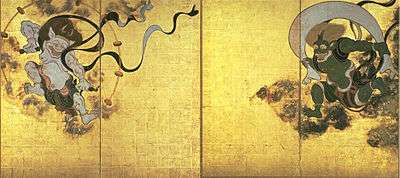Tawaraya Sōtatsu
| Tawaraya Sōtatsu | |
|---|---|
| Born | Kyoto, Japan |
| Nationality | Japanese |
| Known for | Painter |
| Notable work | Fujin Raijin-zu |
| Movement | Rimpa school |


Tawaraya Sōtatsu (俵屋 宗達, fl. early 17th century) was a Japanese artist and also the co-founder of the Rimpa school of Japanese painting.
Biography
Sōtatsu began to work as a fan-painter in Kyoto. Later, he rose to work for the court as a producer of fine decorated papers for calligraphy. He was highly influenced by Kyoto’s courtly culture. Sōtatsu met the great designer and calligrapher Hon'ami Koetsu, and painted under-designs in gold and silver for his writing. Sōtatsu excelled in projects that needed careful placing of decorative screens and fans, and took this to its highest level. He pioneered a new boldness of color and line. He popularized a technique called tarashikomi, which was carried out by dropping one color onto another while the first was still wet.
Sōtatsu also developed an original style of monochrome painting, where the ink was used sensuously, as if it were color. Among his best works are the illustrated covers he painted for the Lotus Sutra.
The Freer Gallery of Art dedicates the first retrospective outside Japan from October 2015 to January 2016.[1]
References
- Gowing, L (ed.) 1995, A Biographical Dictionary of Artists, Rev. edn, Andromeda Oxford Limited, Oxfordshire.
- Murashige, Yasushi. Sōtatsu. Sansaisha, Tokyo, 1970.
External links
![]() Media related to Tawaraya Sotatsu at Wikimedia Commons
Media related to Tawaraya Sotatsu at Wikimedia Commons
- Momoyama, Japanese Art in the Age of Grandeur, an exhibition catalog from The Metropolitan Museum of Art (fully available online as PDF), which contains material on Tawaraya Sōtatsu
- Bridge of dreams: the Mary Griggs Burke collection of Japanese art, a catalog from The Metropolitan Museum of Art Libraries (fully available online as PDF), which contains material on Tawaraya Sōtatsu (see index)